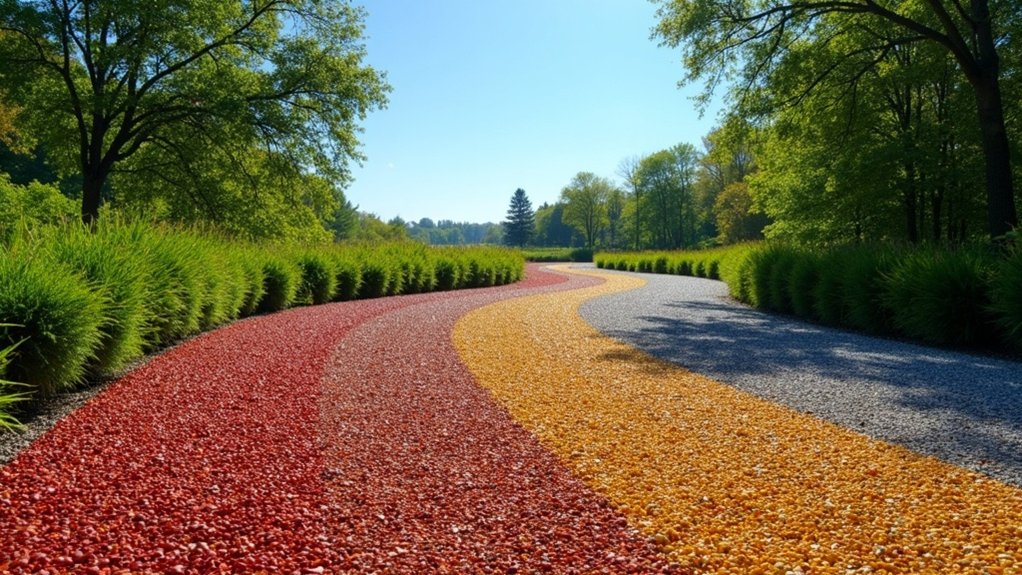Climate plays a vital role in choosing resin-bound gravel colours for your property. Light-coloured stones reflect sunlight and help keep surfaces cool, whilst darker shades absorb heat, which can affect the material’s longevity. In the UK’s variable weather, it’s worth noting that dark gravel can become quite hot during summer heatwaves, whilst lighter options stay more comfortable underfoot.
Installation timing matters too – you’ll need specialist cold-weather resins for winter jobs, but mild conditions are ideal for standard installations. Local council guidelines might restrict colour choices, particularly in conservation areas or listed buildings.
These practical considerations help ensure your resin-bound surface looks great and performs well for years to come. For example, a pale honey-coloured gravel works brilliantly in sun-trapped gardens, whilst rich terracotta blends suit shadier spots without looking gloomy.
Key Takeaways
Colour Choice for Resin-Bound Gravel in British Weather
Light shades keep your driveway cooler in summer by bouncing off sunlight – much like wearing a white t-shirt on a hot day. The lighter surface also helps your resin last longer.
Dark colours work like a sponge for UV rays, which can weaken the resin binding over time. Think of how a black car dashboard becomes brittle after years in the sun.
Mid-tones offer the sweet spot – they look smart whilst hiding everyday marks and wear. These colours work particularly well for British driveways that see plenty of rain and varying weather.
Our changeable UK climate means temperature swings can affect how different coloured surfaces expand and contract. This is especially important when choosing colours for large areas like car parks or garden paths.
In built-up areas, lighter colours help tackle urban overheating – particularly useful in city centres where heat tends to get trapped between buildings.
Impact of Temperature on Color Selection
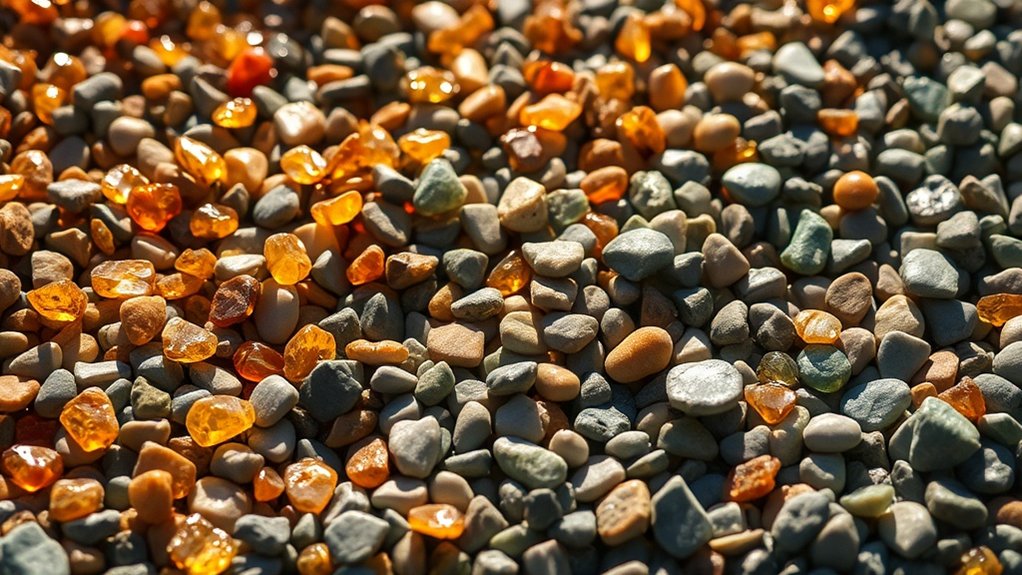
Temperature plays a vital role in resin-bound gravel colour selection for UK installations.
Temperatures below 5°C can prevent proper curing, much like how winter weather affects paint drying. This often leads to patchy results and unstable colours. Additionally, extremely cold temperatures can lead to cracks and fractures in the resin-bound surface, compromising its durability. The proper ground preparation before installation is essential in mitigating these risks.
Hot weather poses its own challenges. Think of how tarmac behaves on a scorching summer day – darker colours absorb more heat, making them prone to fading, whilst lighter shades reflect sunlight and maintain their appearance better.
For best results in the British climate:
- Avoid installation during frosty conditions
- Choose lighter colours for south-facing areas
- Consider darker shades for sheltered spots
- Plan installation during mild weather (10-20°C)
The right colour choice, matched to your local temperature patterns, ensures your resin-bound surface stays attractive and durable throughout the seasons.
Color Choices for Climate-Related Durability
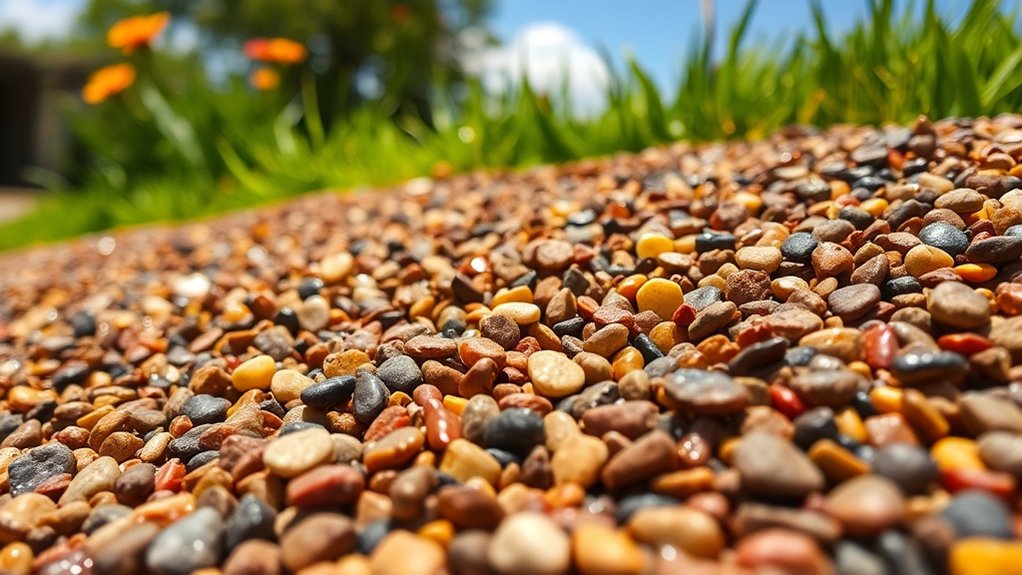
Selecting suitable colours for resin-bound gravel affects both kerb appeal and how well it holds up against British weather. Light colours, such as cream or beige, reflect sunlight and reduce heat build-up – particularly useful during our increasingly warm summers. Dark colours tend to absorb UV rays, which can weaken the resin over time unless properly treated.
Practical considerations matter most in the UK climate. Light shades help hide inevitable moss and algae staining in damp conditions, whilst also minimising damage from winter freeze-thaw cycles. Additionally, the installation’s optimal conditions during installation enhance overall resilience and reduce risks of cracking, allowing for a durable surface that endures various weather challenges.
Dark greys and browns might look smart initially but often show wear more obviously over time. For best results in the British climate, opt for mid-tones that balance durability with maintainability. Popular choices like silver-grey or buff blend well with most properties whilst handling our varied weather conditions.
Mitigating Urban Heat Island Effect With Color
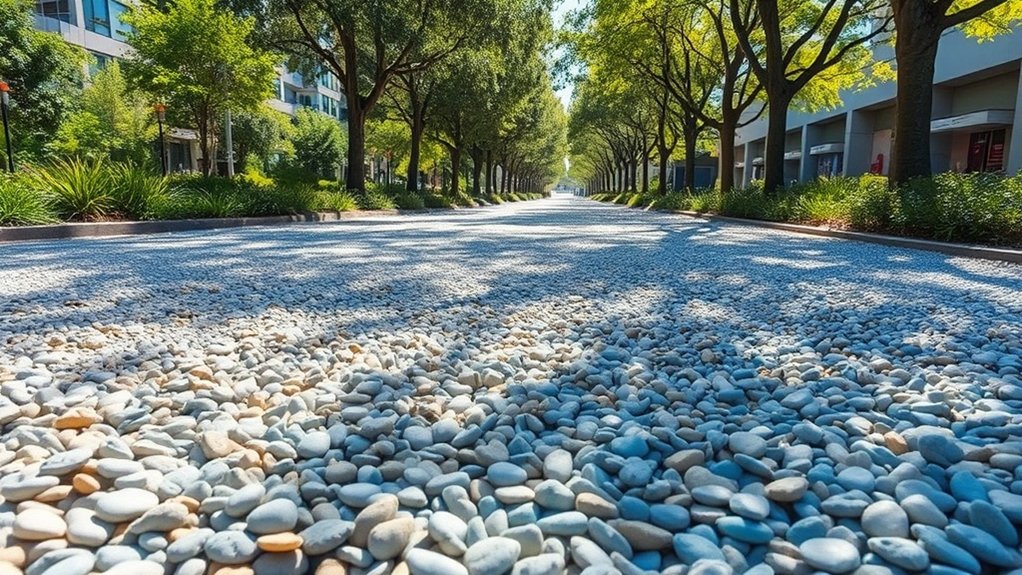
Light-coloured resin-bound gravel plays a vital role in reducing urban heat. These surfaces reflect sunlight rather than absorbing it, helping to lower temperatures across towns and cities. Many UK councils now encourage the use of reflective materials in construction and landscaping, recognising their importance in making urban areas more comfortable during hot weather. The urban heat island effect exacerbates heat retention in cities, making the choice of reflective materials even more critical. Additionally, using sustainable drainage solutions like resin-bound gravel can help manage rainwater more effectively, further supporting cooler urban environments.
Reflective Color Benefits
Reflective colours work effectively to combat Urban Heat Island (UHI) effect – where cities become notably warmer than surrounding countryside. Light-coloured pavements reflect more sunlight, much like wearing a white t-shirt on a hot summer’s day. These surfaces can be 5-8°C cooler than darker alternatives, helping create more comfortable urban spaces.
Light colours strike a practical balance between effectiveness and visual appeal. Most UK communities favour subtle, muted tones that work well with existing architecture whilst maintaining good reflective properties.
Modern reflective coatings help maintain these benefits long-term, even in Britain’s variable weather conditions.
The choice of reflective surfaces benefits both councils and residents: they reduce cooling costs, improve public comfort and contribute to more sustainable cities.
For example, a light-coloured car park surface in Manchester would stay significantly cooler than traditional black tarmac, particularly during increasingly frequent heatwaves.
Thermal Absorption Dynamics
Understanding how resin-bound gravel colours absorb heat is crucial for tackling the Urban Heat Island (UHI) effect in UK cities. The colour you choose makes a real difference to temperature control, much like choosing between a black or white car bonnet on a sunny day.
| Colour Type | Absorption Rate | Thermal Impact |
|---|---|---|
| Dark | High | Increases UHI |
| Medium | Moderate | Balances heat |
| Light | Low | Reduces UHI |
Dark colours soak up more heat, similar to wearing a black t-shirt in summer. Light colours, on the other hand, bounce heat away, helping keep surface temperatures down. This makes lighter shades particularly useful for urban spaces where heat build-up is already a problem.
Urban Regulations Impact
Urban regulations are critical in managing rising city temperatures through strategic use of colours and design. Local councils across the UK mandate light-coloured materials for pavements and roofs to combat the Urban Heat Island (UHI) effect.
Think of the difference between a black tarmac car park and a light-coloured concrete one on a hot summer day – the lighter surface stays notably cooler.
Building regulations now favour pale-coloured materials that reflect rather than absorb heat, much like wearing a white shirt instead of a black one in summer. These rules, combined with requirements for tree planting along streets and in new developments, help create cooler urban spaces.
Such measures are particularly relevant for British cities like London and Manchester, where dense building clusters trap heat.
Supporting these regulations through planning consultations and local council engagement helps build more climate-resilient neighbourhoods whilst reducing cooling costs for homes and businesses.
Environmental Sustainability and Color Considerations
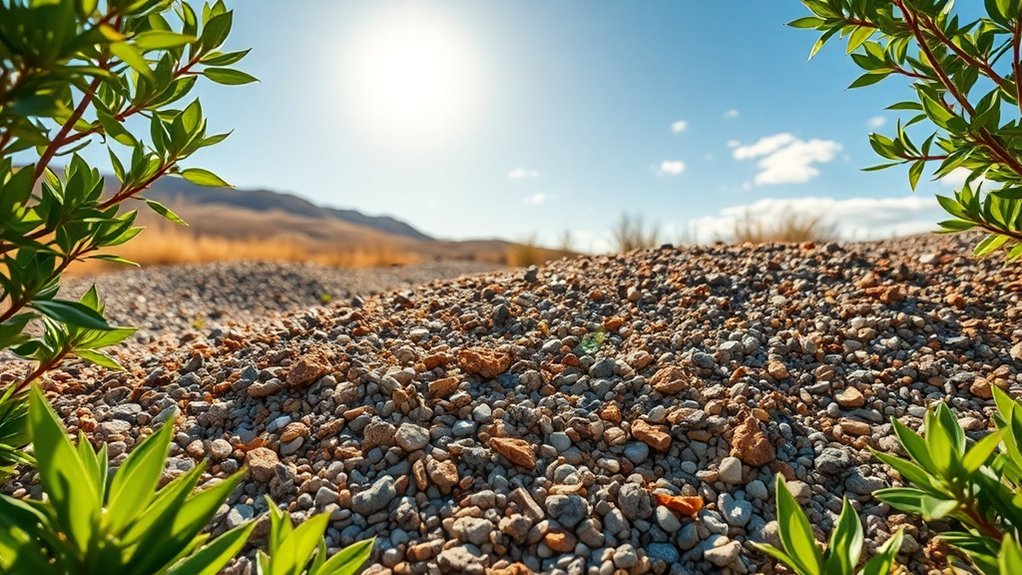
The colour choice for resin-bound gravel isn’t just about looks – it plays a crucial role in environmental impact. Light colours reflect sunlight and help keep spaces cooler, particularly in urban areas where heat builds up. Dark colours do the opposite, absorbing heat and warming the surrounding area.
Your colour selection affects nearby buildings too. Light-coloured surfaces bounce more sunlight away (known as the albedo effect), which can reduce air conditioning needs in summer.
Choosing recycled materials for your gravel mix makes good environmental sense, cutting down on new resource use and harmful run-off.
When it comes to colouring, eco-friendly pigments are worth considering. They’re less toxic and better for the environment than standard options.
Making smart colour choices for your resin-bound surface helps create more sustainable urban spaces, benefitting both the look and environmental impact of your project.
Installation Techniques Adapted to Local Climate
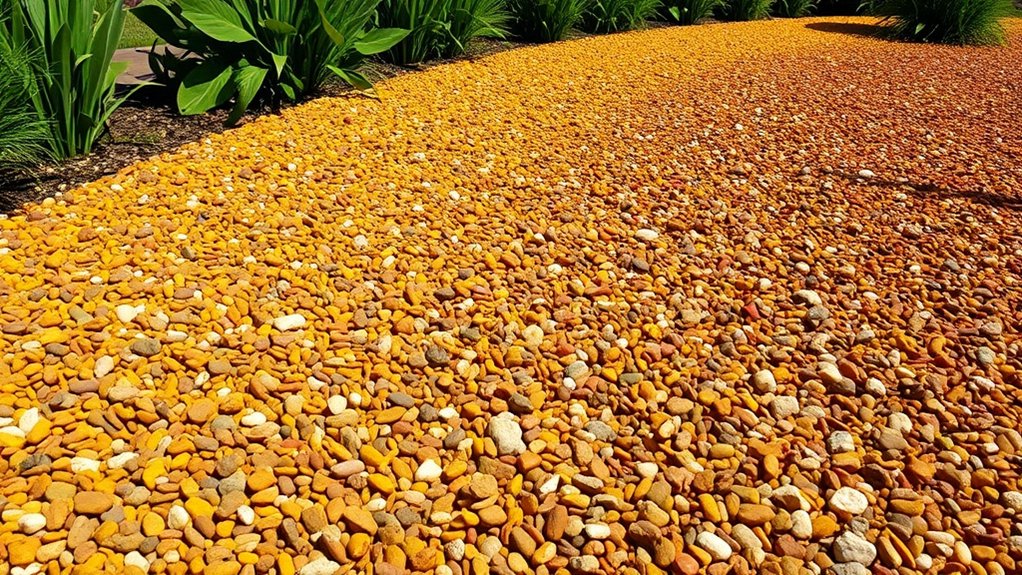
Adapting resin-bound gravel installation to UK weather conditions is crucial for lasting results. The ideal temperature range for installation sits between 5°C and 25°C – typical British weather.
For chilly winter days, use specialist cold-weather resins with catalysts to speed up curing. During rare hot spells, adjust your resin-to-aggregate mix to prevent the surface from curing too quickly.
Proper groundwork is vital – sort out any potholes and ensure good drainage, particularly important given our wet climate.
Choose freeze-thaw resistant resins to cope with British winter conditions, and UV-stable materials to handle summer sun exposure.
Keep your surface in top shape with regular hoovering and careful ice removal in winter.
Getting these climate-specific techniques right means your resin-bound surface will stay smart and functional, whatever the British weather throws at it.
Aesthetic Appeal and Functional Color Choices
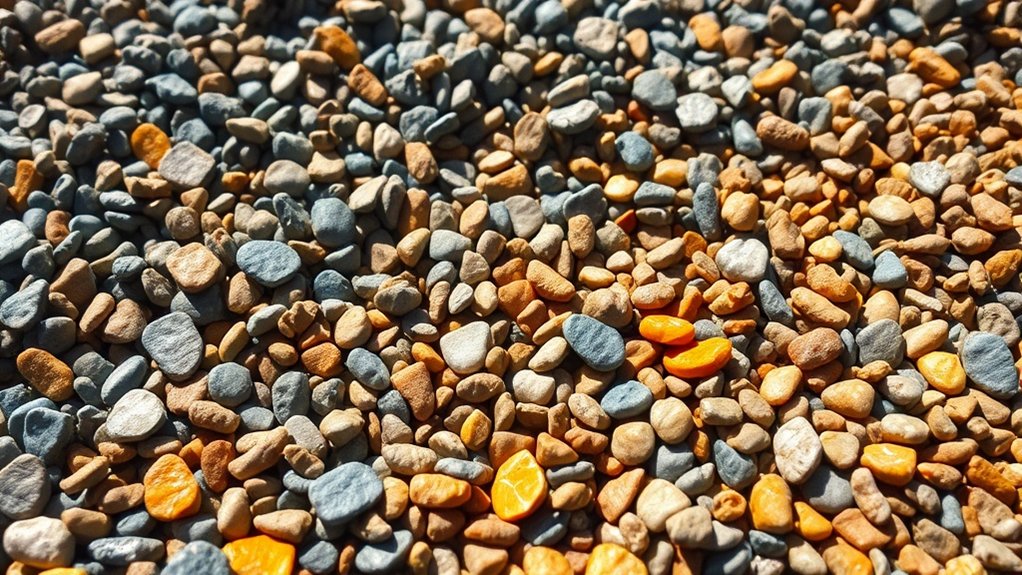
Choosing resin-bound gravel colours requires careful thought about both looks and practicality.
The British climate means your outdoor space will appear differently across seasons, from bright summer days to grey winters. Light-coloured aggregates can brighten darker areas, whilst darker shades work well for high-traffic zones where marks are likely.
For example, a honey-coloured gravel near your front door creates a welcoming entrance that masks daily wear, while pale grey suits garden paths and catches available light.
Match your choice to existing building materials for a cohesive finish that works year-round.
Color Contrast Considerations
Colour Contrast Considerations
Selecting the right colour contrast for resin-bound gravel delivers both visual impact and practical benefits for British weather conditions. Consider these key points:
- Warm vs Cool Tones: Terracotta and amber shades suit traditional UK properties, whilst silver and grey complement contemporary designs.
- Dark and Light Pairings: Darker shades mask typical British weather staining, whilst lighter colours help keep driveways cooler in summer.
- Metallic Effects: Bronze or copper flecks add sophistication and highlight surface texture, particularly effective in garden pathways.
Understanding colour combinations improves both safety and navigation, especially useful for marking steps or changes in level.
A well-chosen contrast ensures your gravel works effectively year-round in British conditions.
Seasonal Lighting Effects
Seasonal Light Effects on Resin Gravel
The appearance of resin-bound gravel colours changes significantly with Britain’s seasonal lighting. Natural daylight affects how vibrant these colours look throughout the year. Winter’s low sun creates longer shadows, dulling brighter shades, whilst summer sunshine makes lighter tones pop. Consider these seasonal effects:
| Season | Light Quality | Colour Impact |
|---|---|---|
| Winter | Low angle, diffuse | Muted, darker tones |
| Summer | Direct, intense | Enhanced vibrancy |
| Autumn | Warm, golden | Rich, warm earth tones |
Much like choosing paint for your garden fence, picking resin colours needs careful thought about year-round lighting. This knowledge proves particularly useful for driveways and paths that need to look smart in all weather conditions.
Understanding these seasonal changes helps select colours that remain practical and attractive throughout the British calendar.
The Role of UV Stability in Color Longevity
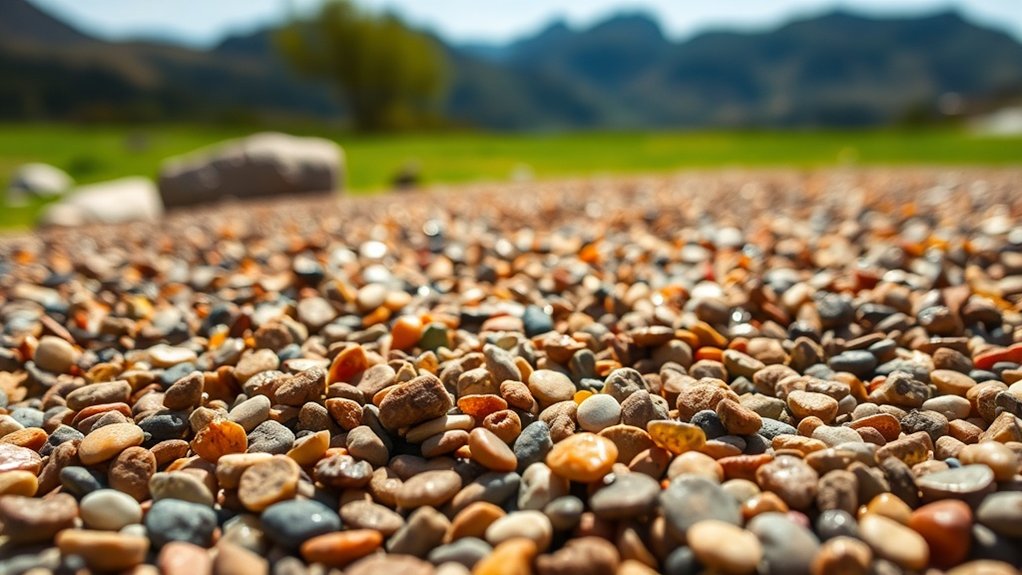
UV Stability: Essential for Resin Colour Protection
UV stability is crucial for maintaining resin-bound gravel surfaces across British gardens and driveways. Without proper UV protection, resin surfaces can quickly fade and deteriorate, much like an old garden fence left untreated in the sun.
- Yellowing Prevention: UV-stable resins stop the surface from turning yellow, keeping colours fresh.
- Extended Lifespan: Proper UV protection helps surfaces last 15-25 years, matching the lifespan of quality garden paving.
- Colour Clarity: Aliphatic polyurethane resins ensure aggregates maintain their original colour, even in harsh British weather.
The quality of UV protection directly affects how well colours last – think of it as sunscreen for your resin surface.
Whether it’s a residential driveway or commercial car park, UV stability remains key to long-lasting results.
Maintenance Strategies for Different Colors
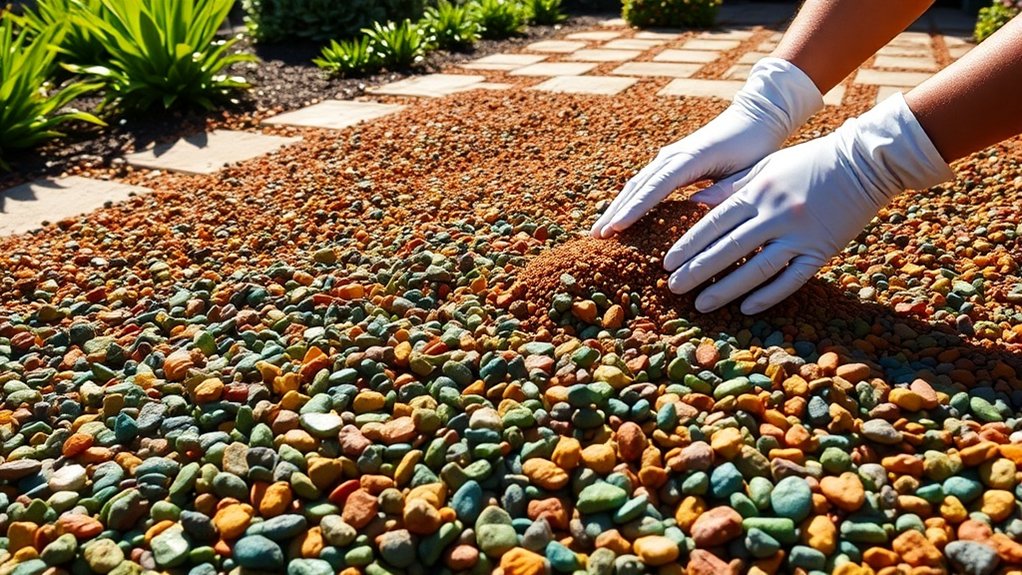
Maintaining Resin-Bound Gravel By Colour
Different coloured resin-bound gravel surfaces need specific care to stay looking their best. Light colours, like cream or beige, need cleaning every two to four weeks, especially if you’ve got overhanging trees or heavy foot traffic.
Dark colours, such as charcoal or brown, are more forgiving and typically need a good clean just twice or four times yearly.
Watch out for oil spills and chemical marks on light surfaces – they’ll show up like a sore thumb and need swift attention.
For all colours, stick to mild, pH-neutral cleaners (think washing-up liquid strength) to avoid damaging the surface.
Regular once-overs to remove leaves and debris are vital, particularly during autumn and winter when wet conditions can encourage moss growth.
A quick sweep and occasional pressure wash, matched to your surface’s colour needs, will keep your resin-bound gravel looking smart for years.
Influence of Color on Surface Temperature
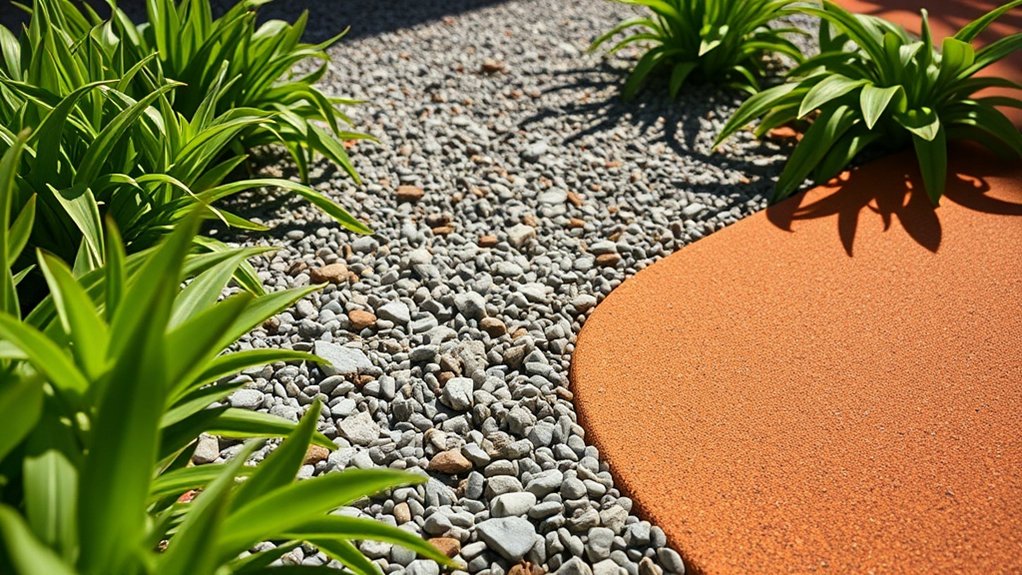
Dark-coloured resin-bound gravel heats up more quickly in the sun, whilst lighter shades stay cooler by reflecting sunlight.
This matters particularly in British gardens and driveways, where a darker surface could become uncomfortably warm during summer months.
For instance, charcoal or black surfaces might reach temperatures 10-15°C higher than similarly installed cream or limestone options.
Worth considering this when choosing colours, especially for areas that get direct sunlight or where children and pets might play.
Heat Absorption Rates
Heat Absorption in Resin Surfaces
The colour of resin-bound gravel significantly influences surface temperature, directly impacting your garden or driveway’s comfort level.
Think of it like choosing between a black or white car bonnet on a sunny day.
Three critical factors:
- Dark colours (like charcoal or deep brown) absorb substantial heat, making surfaces hot to touch – particularly problematic for children’s play areas and pet-friendly spaces.
- Light colours (such as cream or pearl) deflect sunlight effectively, maintaining cooler temperatures and making the surface more practical for summer use.
- Resin-bound surfaces naturally heat up more slowly than traditional tarmac or concrete, much like how a stone patio stays cooler than asphalt during heatwaves.
Color Reflectivity Benefits
Light-coloured resin-bound gravel offers significant temperature control benefits through its reflective properties. Much like a white t-shirt on a sunny day, these surfaces reflect more sunlight, staying notably cooler than darker alternatives. This helps protect the material from heat damage and extends its life.
The cooling effect makes outdoor areas more pleasant to use, particularly in summer months. Think of a car park – light-coloured surfaces mean cooler vehicles and more comfortable walking spaces.
These surfaces also reduce heat absorption around buildings, which can lower air conditioning costs and help combat the warming effect common in UK cities.
For British homeowners and developers, choosing lighter shades is a practical way to manage temperature whilst maintaining an attractive finish. The benefits are particularly noticeable during our increasingly warm summers, making outdoor spaces more usable year-round.
Seasonal Temperature Impact
Seasonal Temperature Impact
Temperature changes affect resin-bound gravel differently based on its colour, influencing both performance and lifespan. The choice of colour matters more than you might think:
- Darker colours soak up heat readily, making surfaces hot to touch and potentially soft during British summers – think of a black car bonnet on a sunny day.
- Lighter colours stay cooler naturally, offering better comfort for driveways and garden paths in warmer weather.
- Temperature swings between seasons can cause cracking, so choosing colours that handle heat well is vital for long-term durability.
The right colour choice goes beyond looks – it’s crucial for ensuring your resin-bound gravel lasts through Britain’s varied weather patterns.
Color Contrast and Surrounding Materials
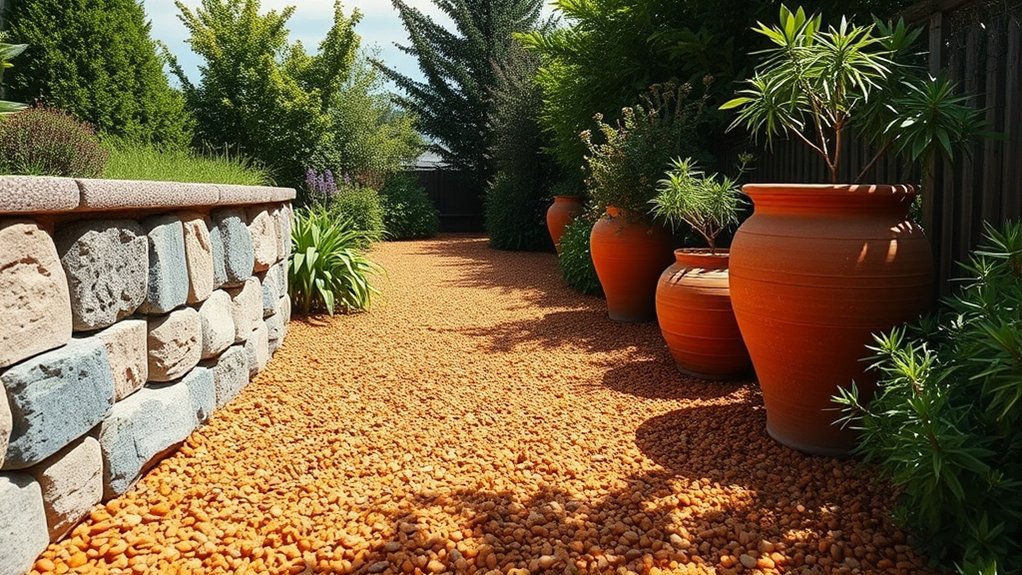
Choosing resin-bound gravel colours requires careful thought about how they work with your surroundings. Bold contrasts, such as black gravel with silver flecks, suit modern homes and make a striking statement.
For traditional properties, lighter shades like cream or buff blend beautifully with period features.
Consider your existing materials – if you’ve got red brick walls, warm-toned gravel will create a cohesive look, whilst a contrasting shade can add drama. Many UK homeowners opt for golden or honey-coloured gravel to complement classic British architecture.
Border colours matter too. A darker edge around lighter gravel, or vice versa, helps define pathways and driveways clearly.
Think about practical aspects – lighter colours show dirt more easily, while darker shades can fade slightly in strong sunlight.
The right colour combination will enhance your property’s kerb appeal whilst serving its practical purpose.
Remember to request samples and view them in different lights before making your final choice.
Local Regulations and Climate-Suitable Color Choices
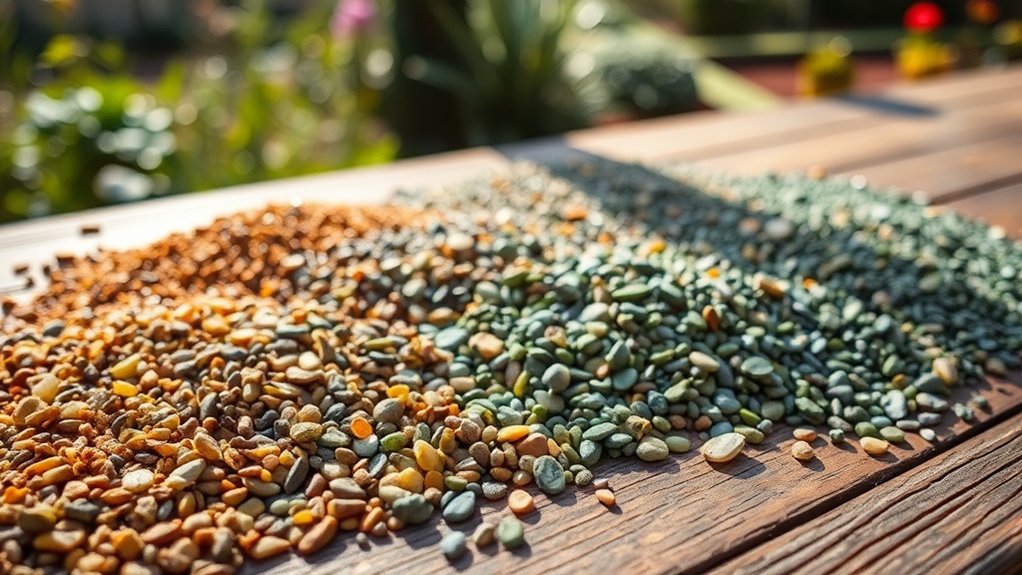
Choosing Resin-Bound Gravel Colours: Local Guidelines and Weather Considerations
Local council regulations directly shape the choice of resin-bound gravel colours across the UK. Follow these key requirements:
- Colour Approval: Most councils require colour sample submissions at least five working days before installation. For example, a warm honey-coloured aggregate might suit a Cotswolds conservation area, whilst darker tones often work better in urban settings.
- Weather Resistance: British weather demands UV-stable pigments to prevent fading, particularly in coastal areas and south-facing driveways where sun exposure is highest.
- Light Reflection: Council planning often restricts overly bright or reflective surfaces. Mid-tone colours like buff or grey typically meet these requirements whilst remaining practical for most settings.
These guidelines ensure your resin-bound surface complements its surroundings and stands up to British weather conditions.
Frequently Asked Questions
How Do Different Colors Affect the Lifespan of Resin-Bound Gravel?
Colour plays a crucial role in how long resin-bound gravel lasts. Dark colours like black and charcoal grey tend to absorb more heat, much like a black car bonnet on a sunny day, which can make the resin age faster. Light colours such as cream and pale grey reflect the sun’s rays, similar to wearing light clothing in summer, helping the surface stay cooler and maintain its appearance for longer.
Can Color Choice Impact the Cost of Resin-Bound Gravel Installations?
Yes, colour choice significantly affects resin-bound gravel costs. Premium colours, particularly UV-stable options like earth tones and greys, cost more than standard mixes. For instance, a natural buff or Thames blend might cost £5-10 more per square metre than basic colours. Whilst pricier initially, these quality pigments resist fading and wear, potentially saving money on repairs or replacements down the line.
What Are the Best Practices for Cleaning Different Colored Surfaces?
Proper surface cleaning varies by colour, requiring specific care for different shades. Light-coloured surfaces, such as cream worktops or white tiles, show marks quickly and need daily wiping with gentle cleaners. Dark surfaces, like mahogany furniture or black granite, hide dust better but should still receive weekly attention. Opt for pH-neutral cleaning solutions from your local supermarket rather than harsh bleaches or abrasives that might damage the finish. A microfibre cloth works brilliantly on most surfaces, whilst a soft sponge suits textured materials.
Are There Color Options Specifically Designed for High-Traffic Areas?
Colour options specially designed for high-traffic areas focus on durability and practicality. Deep browns, charcoal greys and rich earthy tones work brilliantly to mask scuffs and daily wear. Think of busy hotel lobbies or shopping centres – these spaces often use darker, resilient shades that maintain their appearance despite constant foot traffic.
How Can Color Choice Influence Property Value in Various Climates?
Property colours significantly impact both kerb appeal and market value across different climates. In the UK’s varied weather, light-coloured exteriors reflect heat during warm months and appear welcoming in overcast conditions. Cream and soft grey tones prove popular amongst British buyers, whilst darker shades like slate and navy can add sophistication to period properties. Neutral colour schemes tend to maintain better resale value, as demonstrated by London estate agents reporting stronger interest in traditionally painted homes. Climate considerations matter – coastal properties benefit from salt-resistant paints, whilst urban homes often fare better with dirt-resistant finishes.
Conclusion
When selecting resin-bound gravel colours, climate plays a crucial role in your decision. Dark shades absorb more heat, potentially making driveways and paths uncomfortably warm during British summers. Lighter colours reflect sunlight better, helping maintain cooler surface temperatures. Consider how your choice will work year-round – a practical balance between aesthetics and comfort is essential. For south-facing driveways particularly exposed to sunlight, pale greys and beiges often prove most suitable.
